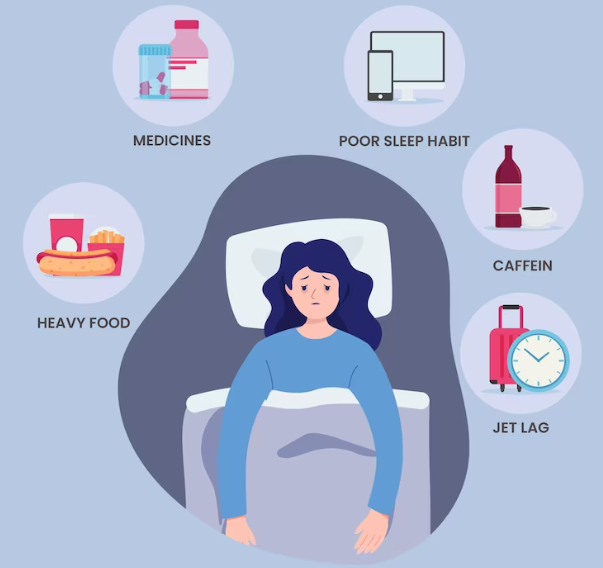
Obstructive Sleep Apnea is characterized by episodes of breathing cessation or shallow breathing in sleep. These occurrences are brought on by the full or partial collapse of the upper airway. Most frequently, snoring, oxygen desaturation and brief awakenings from sleep are linked to respiratory events. Sleep apnea is usually worse during lying and rapid eye movement sleep. Diagnosing and managing obstructive sleep apnea is critical for improving the overall health and quality of life of affected individuals. An extensive review of the patient’s medical history and symptoms, such as severe daytime sleepiness, loud snoring, and observed breathing pauses during sleep, is usually the first step in the diagnosis process.
The monitoring of several physiological factors while a person sleeps, including airflow, oxygen saturation and brain activity is known as Polysomnography and is an important diagnostic technique for OSA. Home sleep apnea tests are also increasingly used for initial screening. The severity of the condition determines the management techniques for OSA once it has been diagnosed. For mild cases, lifestyle changes like losing weight, abstaining from alcohol and sedatives, and positional therapy can be helpful. Obstructive sleep apnea affects 34% of men and 17% of men in the US and has a similar prevalence in other countries.
Approach Considerations
Obstructive sleep apnea should be treated and diagnosed promptly. For OSA patients, board-certified sleep specialists assess polysomnography (PSG) data and propose a course of treatment. The severity of the sleep-disordered breathing affects the course of treatment. People with mild to moderate apnea have more options, however those with moderate to severe apnea should use nasal continuous positive airway pressure (CPAP) as a treatment.
Conservative nonsurgical treatment includes general and behavioral strategies like weight loss, abstaining from alcohol for 4-6 hours before bedtime and sleeping on one’s side rather than their stomach or back. Weight loss lowers the risk of OSA as obesity is a primary indicator of the condition. The benefits of weight reduction in patients with sleep-disordered breathing include the following:
- Lowered blood pressure
- Decreased RDI
- improved lung function and arterial blood gas values
- Improved snoring and sleep structure
- Optimal CPAP pressure may need to be reduced.
Observations
The most ordinary presenting symptom of obstructive sleep apnea is excessive sleepiness, although this symptom is reported by as few as 15% to 50% of people with OSA in the general population. A 2- to 3-fold greater risk of cardiovascular and metabolic disorders is linked to OSA. In many patients, obstructive sleep apnea can be diagnosed with home sleep apnea testing, which has a sensitivity of approximately 80%. Successful interventions comprise weight reduction and physical activity, positive airway pressure therapy, employing oral devices that reposition the jaw while sleeping, and surgical alterations to enhance the upper airway through adjustments to either the pharyngeal soft tissues or facial skeleton.
In some patients with a body mass index under 32, Hypoglossal nerve stimulation is beneficial. There are currently no effective Pharmacological therapies. Positive airway pressure therapy lowers blood pressure, particularly in individuals with resistant hypertension. Randomized clinical trials of OSA treatment however, have not found any appreciable reduction in the rates of cardiovascular or cerebrovascular events.
Diagnosis of Obstructive Sleep Apnea
Obstructive sleep apnea (OSA) must be diagnosed for the affected person to receive successful treatment and see an improvement in their quality of life. Patients frequently go through a detailed medical history evaluation that includes queries regarding symptoms like exhaustion, excessive daytime sleepiness, loud snoring, and choking or gasping while sleeping. One of the most frequent diagnostic tools for OSA is Polysomnography, an overnight sleep study that tracks many physiological factors, including brain activity, heart rate, airflow,and oxygen levels during sleep.
Management of Obstructive Sleep Apnea
Treatment for OSA can frequently correct its systemic consequences, but it may also result in lasting brain changes that hinder the full recovery of psychomotor functioning deficiencies. Effective management of OSA can be categorized as either a “cure” or “success”. Obstructive Sleep Apnea (OSA) is often treated using a variety of approaches designed to address the underlying causes and enhance the patient’s quality of life. Numerous tactics are used in efficient therapies. Due to the fact that being overweight might contribute to airway obstruction, lifestyle changes including weight loss and consistent exercise are frequently advised.
Conclusion and Relevance
Obstructive Sleep Apnea is common and the prevalence is increasing with the increased prevalence of obesity. While daytime sleepiness is among the most prevalent symptoms of OSA, many people do not experience any symptoms at all. Patients with OSA who are asymptomatic or whose symptoms are only mildly concerning and do not appear to pose a risk to driving safety may be treated with behavioral techniques like exercise and weight loss. Interventions such as positive airway pressure are recommended for those with resistant hypertension and excessive sleepiness. There is currently insufficient high-quality evidence to support managing asymptomatic OSA to lower cardiovascular and cerebrovascular events. If you’re seeking expert guidance for the diagnosis and management of Obstructive Sleep Apnea, look no further than contacting Dr. Sheetu Singh. She is a well-respected expert in the field of sleep medicine, renowned for her depth of understanding and caring for her patients.


3 comments
binance us registrace
November 5, 2024 at 9:26 am
Your point of view caught my eye and was very interesting. Thanks. I have a question for you.
binance
November 6, 2024 at 6:58 am
Your article helped me a lot, is there any more related content? Thanks!
www.binance.com registrera dig
December 2, 2024 at 6:39 am
Thank you for your sharing. I am worried that I lack creative ideas. It is your article that makes me full of hope. Thank you. But, I have a question, can you help me?